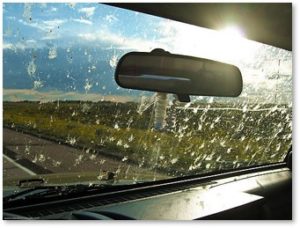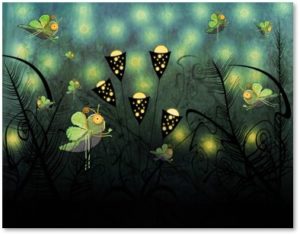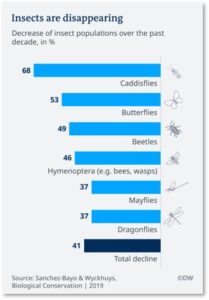 When I was a kid, driving around in the family car meant that the windshield got splattered with squashed bugs—and that made a real mess. Sometimes, you had to run the wipers just to clear the glass. When it got really bad, you had to scrape the gushy mess off. Dead insects clogged the radiator and had to be washed off the front bumpers.
When I was a kid, driving around in the family car meant that the windshield got splattered with squashed bugs—and that made a real mess. Sometimes, you had to run the wipers just to clear the glass. When it got really bad, you had to scrape the gushy mess off. Dead insects clogged the radiator and had to be washed off the front bumpers.
The Windshield Phenomenon
I can’t remember the last time I had to wash insects off the windshield. Can you? We now have a name for this common observation: it’s called the Windshield Phenomenon.
 Back then, insects buzzed around streetlights. June bugs batted against window screens. Fireflies blinked under the shrubs. Moths clung to walls. Grasshoppers whirred and jumped in the high grass. And all kinds of insects struggled in spider webs. Now, streetlights glow unobstructed, nothing hops in the grass, the garden has no spiderwebs, and our great grandchildren may never see a firefly outside of a picture book.
Back then, insects buzzed around streetlights. June bugs batted against window screens. Fireflies blinked under the shrubs. Moths clung to walls. Grasshoppers whirred and jumped in the high grass. And all kinds of insects struggled in spider webs. Now, streetlights glow unobstructed, nothing hops in the grass, the garden has no spiderwebs, and our great grandchildren may never see a firefly outside of a picture book.
Dying in Nature Reserves
We worry about losing honeybees, ladybugs, fireflies and Monarch butterflies but the less “charismatic” insects are dying, too—and in large quantities. The mass of insects collected by monitoring traps in the Orbroicher Bruch nature reserve in northwest Germany dropped by 78% in 24 years. And that’s in a place where native plants and animals are protected.
Some of us may think this is a good thing. After all, bugs are creepy crawly things that often intrude on our lives. Who needs mosquitoes, ticks, spiders, and chiggers? It turns out that a lot of creatures do and removing them has repercussions up the food chain. Dragonflies, for example, eat mosquito larvae. Birds and bats eat insects of all kinds. Possums eat ticks. Spiders eat anything in their webs.
Plus, insects pollinate plants, prey on one another and comprise nature’s clean-up crew. They break down leaves, dead animals, dung and dead trees. Insects recycle nutrients and make them available again.
Where Did All the Insects Go?
We never thought this would happen. As humans improved our ability to alter and remake our environment, we often proved careless or disinterested in unexpected consequences. It happened gradually and we barely noticed as fewer and fewer insects filled the air and crawled on the ground.
The researchers in a new Biological Conservation paper outline several broad, global situations that lead to insect loss. They won’t surprise you.
- Habitat loss as a result of human development, deforestation, and the expansion of agriculture
- Pollution, particularly via pesticides, fertilizers, and industrial wastes
- Parasites and pathogens — like the viruses that attack honeybees — and invasive species
- Climate change alters the balance, with warm-weather insects moving further north and higher in elevation where they have no natural predators
- Light pollution leads nocturnal insects astray
Insecticide: Culprit #1
Yes, we wanted to get rid of mosquitoes. They carry terrible diseases like malaria, dengue fever, West Nile virus, yellow fever, tularemia and Eastern equine encephalitis.
So, we sprayed—and we’re still spraying. But insecticides don’t just attack specific insects; they take out a lot of other species at the same time. Did we understand that? The special culprits are neonicotinoids and nitrogen fertilizers, which have been linked to a multitude of problems.
We like nice, green lawns, too. So, we sprayed some more. In case you didn’t realize these substances, were toxic, remember the warnings not to let your pets out on the lawn after a treatment? Yeah, that.
Leif Miller, Director General of the German chapter of BirdLife International, says, “There are many indications that what we see is the result of a widespread poisoning of our landscape.”
 Habitat Destruction: Every time we take down wild areas and replace them with housing developments, streets, sidewalks, malls, and parking lots we take away the habitats where insects live.
Habitat Destruction: Every time we take down wild areas and replace them with housing developments, streets, sidewalks, malls, and parking lots we take away the habitats where insects live.
We now have laws against filling wetlands but it still happens. We also destroy the plants on which insects feed and the places where they breed. While some insects are indestructible—think cockroaches and bed bugs—others cannot survive such disruption.
Intensive agricultural practices, agricultural pollutants, invasive species and climate change also contribute to the decline. Monoculture crops like corn and soybeans leave the insects nowhere to feed or reproduce. The rate of extinction is fast—very fast. Insect populations are going extinct eight times faster mammals, birds and reptiles.
What the Insects Contribute
Why is this important? A UN Environment Foresight Brief published in January states that:
“Insects make up about half of all known living organisms. They play key roles in, pollination, nutrient cycling, food chains of birds and other insectivores, and are one of the pillars of our ecosystems. However, the wide use of insecticides, fragmentation of habitats and climate change are placing multiple threats on them, and their populations are under sharp decline.”
What Can We Do to Help?
 We can take some steps to improve the situation:
We can take some steps to improve the situation:
- Increase crop yields by planting flower strips and hedgerows to provide nesting sites.
- Return some fields to fallow status periodically.
- Use pesticides in a more targeted way.
- Restore semi-natural and natural areas faster and better.
- Set up insect conservatories and butterfly farms.
- Create more green spaces in cities.
- Plant wildflowers along roadsides and on traffic medians.
The loss of our insect populations doesn’t just affect what the insects themselves do. It also impacts other species. More on that in another post.

